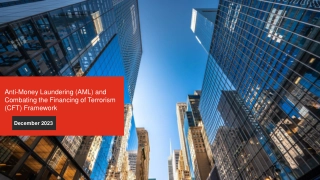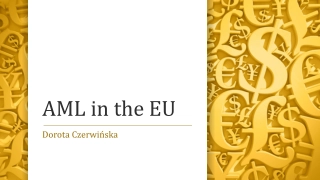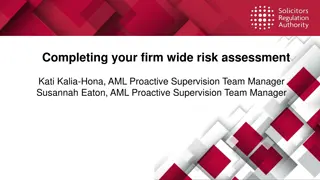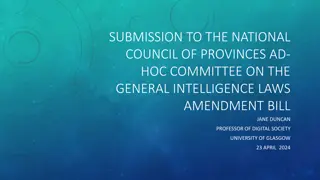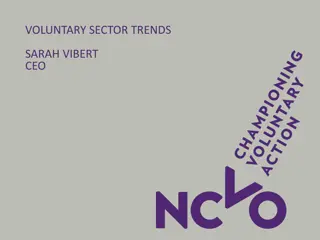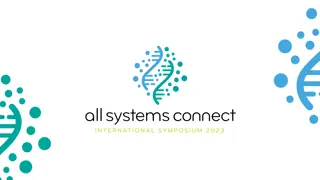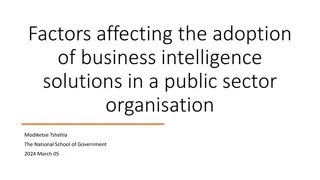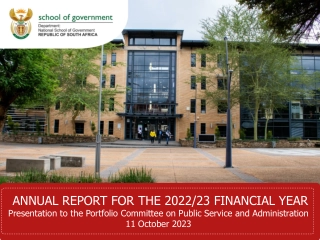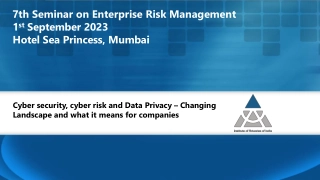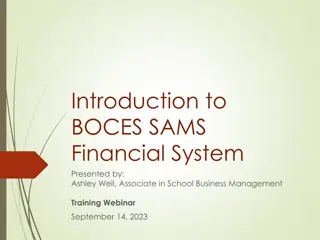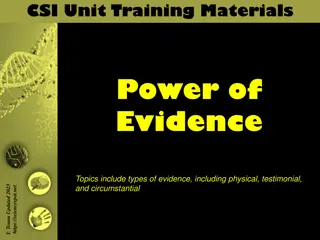AML/CFT Training for Casinos Sector - Eswatini Financial Intelligence Unit
Explore the comprehensive AML/CFT training program for the casinos sector by the Eswatini Financial Intelligence Unit. Covering regulatory frameworks, money laundering, terrorism financing, AML program overview, critical pillars, FATF standards, and domestic regulations. Learn about the Swaziland Financial Intelligence Unit's establishment and basic functions.
Download Presentation
Please find below an Image/Link to download the presentation.
The content on the website is provided AS IS for your information and personal use only. It may not be sold, licensed, or shared on other websites without obtaining consent from the author. Download presentation by click this link. If you encounter any issues during the download, it is possible that the publisher has removed the file from their server.
Presentation Transcript
AML/CFT TRAINING FOR THE CASINOS SECTOR ESWATINI FINANCIAL INTELLIGENCE UNIT
Contents 1. Regulatory Background 2. Domestic Regulatory Framework 3. Money Laundering: Definition, Stages, & Red Flags 4. Terrorism Financing: Definition & Red Flags 5. AML Program Overview 6. AML Examples 7. Critical AML /CFT Pillars Governance and Oversights Risk Assessment and RBA Customer Due Diligence Employee Screening and Training Transaction Monitoring and Reporting Record Keeping Targeted Financial Sanctions 8. Suspicious Transactions Questions to consider
FATF AND INTERNATIONAL STANDARDS The Financial Action Task Force (FATF) is an inter-governmental body established in 1989 by the Ministers of its Member jurisdictions. The mandate of the FATF is to set standards and to promote effective implementation of legal, regulatory and operational measures for combating Money laundering (ML) and Terrorist Financing (TF), the financing of proliferation, and other related threats to the integrity of the international financial system. In collaboration with other international stakeholders, the FATF also works to identify national-level vulnerabilities with the aim of protecting the international financial system from misuse.
DOMESTIC REGULATORY FRAMEWORK Money Laundering and Financing of Terrorism,2023 Suppression of Terrorism Act, 2008 Prevention of Corruption of Act,2018
WHO ARE WE? An entity established in compliance with FATF Recommendation #29 Countries should establish a financial intelligence unit (FIU) that serves as a national Centre for the receipt and analysis of: (a) suspicious transaction reports; and (b) other information relevant to money laundering, associated predicate offences and terrorist financing, and for the dissemination of the results of that analysis. The FIU should be able to obtain additional information from reporting entities, and should have access on a timely basis to the financial, administrative and law enforcement information that it requires to undertake Established under section 19 of the Money Laundering and Financing of Terrorism Prevention Act, 2011 as amended in 2016. A financial intelligence unit to be known as the Swaziland Financial Intelligence Unit ( SFIU ) is hereby established which shall be an autonomous central national agency responsible for receiving, requesting, analysing and disseminating to competent authorities disclosures of financial information as required under this Act in order to counter money laundering and financing of terrorism
BASIC FUNCTIONS OF THE SFIU RECEIVE ANALYSE DISSEMINATE
Money Laundering A person commits an offence of money laundering if the person knows or ought to have known that property is or forms part of the proceeds of unlawful activity and the person: converts, conceals, disguises or transfers the property; conceals or disguises the unlawful origin of the property; acquires, uses or takes possession of the property This involves taking criminal proceeds and disguising their illegal sources in order to use the funds to perform legal or illegal activities. It is process of making dirty money look clean. Example: What is Money Laundering Regulatory Definition: Laundering of money undergoes 3 different stages after which the funds from the illicit criminal activities are made legitimate and integrated into the financial system. A person commits an offence if the person knows or ought to have known that another person has obtained proceeds from an unlawful activity and enters into an agreement with that other person or engages in a transaction where: the person facilities the keeping or control of the proceed from the unlawful act. The person uses the proceed to acquire a property for himself or on behalf of another person. 03 02 01 Customer wants to be anonymously. Customer converts large sum of money to purchase casino value instrument CRIMINAL PROCEEDS LAUDERED INTERGRATION LAYERING PLACEMENT Customer deposits cash to purchase casino value instrument and claim back fund without playing Getting the criminal proceeds into the financial system Reintroducing the funds into the economy in such a way as to make them legitimate Moving the criminal funds to other accounts to further obscure their origin and ownership Red Flags Customer deposits cash to purchase casino value instrument which are slightly below the reporting threshold Customer deposits cash to purchase casino value instrument and claim back funds playing minimally. Issuing winnings to a third party
Terrorist Financing Structured cash deposits into an account by Terrorist financing can be simply defined as different individuals at multiple branches of a financial support, in any form, of terrorism particular bank; or of those who encourage, plan, or engage in terrorism. It is the process by which Red Flags Transfer of large sums of money to and from What is Terrorist Financing terrorists fund their operations in order to accounts of individuals or newly established perform terrorist acts. companies with no apparent business relationships; Terrorists need financial support to carry out their activities and to achieve their goals. Frequent cash deposits into or withdrawals from There is little difference between terrorists charity accounts by different individuals with no and other criminals in their abuse of the apparent relationships; financial system. While different from Unexplained transfer of funds from foreign money laundering, terrorists often exploit jurisdictions with high incidence of terrorist similar weaknesses in the financial system. activities into the accounts of individuals and companies;
AML Compliance Program Transaction Monitoring and Regulatory Reporting Screening Tool (Real or near-real time, delay period) Alerts (# of alerts, Parameters, Case Management Suspicious Transaction/Activity Monitoring (STR/SAR) Cash Threshold Reporting (CTR) Risk Based Approach Business Risk Assessment Geographical (Country & Regional) Risk assessment Product Risk Assessment Customer Risk Assessment Customer Due Diligence Standard Due Diligence Enhanced Due Diligence On-going Due Diligence Training & Awareness Board Senior Management Staff Training (Customer Facing Staff) Record keeping Customer on-boarding documents Transactional Data Regulatory Correspondence Strategy & Risk Appetite Financial Crime Strategy Compliance matters part of Board agenda Governance and Oversight AML Officer, should be sufficiently senior, & independent of the business operations Risk & Compliance s review methodology Independent annual review of the AML Programme Screening Screening Lists (source & frequency of updates) Sanctions and PEP screening On-boarding & Ongoing screening Management of exceptions (investigation and whitelisting of PEPs & Sanctions false positives)
Risk-Based Approach in Terms of the Money Laundering & Financing of Terrorism Act,2011 Section 6 of MLFTP (Amendment)Act requires Accountable Institution to adopt a risk-based approach in managing their ML/FT risk. There are required in terms of the Act to do the following; Put in place appropriate processes to identify, assess, monitor, manage and mitigate ML/TF/PF risks, including but not limited to risks that may arise in relation to the development of products, business practices and delivery channels or risks that may arise through the use of new or developing technologies & take AML/CFT/PF measures commensurate to those risks in order to mitigate them effectively. Ensure that it has adequate resources to fulfill the obligations above.
THE RISK BASED APPROACH IN TERMS OF THE MONEY LAUNDERING & TERRORIST FINANCING ACY,2011 conduct enhanced ongoing monitoring of the business relationship. take reasonable measures to determine whether a customer or beneficial owner is a PEP, domestic or international. In cases of a higher risk business relationship with such persons, institutions must apply enhanced due diligence (EDD) measures before accepting the relationship. The requirements for all types of PEP should also apply to family members or close associates
Governance and Oversight Board takes ultimate responsibility of compliance risk management; Creation of AML Compliance Function and appointment of AMLCO; The different lines of Defense; 1st , 2nd and 3rd Lines of Defense; o First Line Operations (Customer Facing staff) o Second Line Compliance Unit o Third Line IAFS, External Auditors Development and Approval of AML Policy and other AML Procedures; Compliance Monitoring planning, execution and reporting.
Risk Assessment and Risk Based Approach Risk Identification, Risk Evaluation, Risk Control and Reporting Risk Based Approach as opposed to Rule Based Approach AML Risk Factors Geographic Risk Factors; Product / Service Risk Factors; and Delivery Channel Risk Factors Customer Risk Factors o Customer Risk Profiling
Customer Due Diligence Due Diligence Process Gather Client Documentation Verify Client Information Provide CIP Notice to Customers Conduct Sanctions Screening Enforce Adequate Record Retention Policies Levels Customer Due Diligence Simplified CDD Low Risk Subscribers Standard CDD Medium Risk Subscribers Enhanced CDD High Risk Subscribers
Employee Screening and Training Development and Implementation of Know Your Employee (KYE) Policy; o At on-boarding o Continuously Provision of role-based AML/ CFT training to staff. Staff groups may include; o Operations Staff o Sales Staff; o Customers Facing Staff o Compliance Staff Training; o Board AML Training
Suspicious Transactions Monitoring and Reporting Transactions are to be monitored daily to identify suspicious transactions / activity in platform Automated / Manual Monitoring All confirmed suspicions are reported to Eswatini Financial Intelligence Unit by AMLCO All staff members are required to also report suspicions transactions / activity Reporting should be done withing 48 hour after forming suspicion No Tipping Reporting should be done confidentially
Record Keeping An accountable institutions shall keep the records for: not less than five (5) years after the date on which a relationship is terminated in case of a business relationship; and not less than five (5) years after the date a transaction is concluded. These records include customer KYC documents ,transactions data, copies suspicious transactions reports, correspondences from Regulators These records assist law enforcement Agencies as they investigation money laundering cases. If law enforcement require these records, Institutions have to retrieve these records within 48 hours.
Targeted Financial Sanctions Terrorist groups and Individuals are known, and a list is maintained; Al Qaeda, Boko Haram OFAC, UN, EU Sanction lists. These list are regularly reviewed All Happy Valley Customers should be screened against sanctions list at on-boarding and on a continuous basis; Matched Entities and individuals are to be reported to both EFIU and CBE timeously.
SUSPICIOUS TRANSACTIONS Transactions, whether completed or attempted, may give rise to reasonable grounds to suspect that they are related to money laundering or terrorist activity. There is no monetary threshold for making a report on a suspicious transaction. The context in which the transaction occurs or is attempted is a significant factor in assessing suspicion. This will vary from business to business, and from one client to another. Suspicion is subjective. Transactions should be evaluated in terms of what seems appropriate and is within normal practices in your particular line of business, and based on your knowledge of your client.
REASONS FOR SUSPICION There are broad categories of reason for suspicion. Below are some examples; Identity of client False identification documents Identification documents which could not be verified within reasonable time Background of client Suspicious background or links with known criminals
REASONS FOR SUSPICION Multiple accounts Large number of accounts having a common account holder or authorized signatory with no rationale, Unexplained transfers between multiple accounts with no rationale Activity in accounts Unusual activity compared with past transactions Sudden activity in dormant accounts Activity inconsistent with what would be expected from declared business
REASONS FOR SUSPICION Value of transactions Value just under the reporting threshold amount in an apparent attempt to avoid reporting; Value inconsistent with the client s apparent financial standing; Inconsistency in the payment pattern by client;
REPORTING OF SUSPICIOUS TRANSACTIONS A suspicious transaction is submitted directly to the EFIU: in writing and may be given by way of mail, telephone to be followed up in writing, fax or electronic mail or such other manner as may be prescribed by the EFIU, Be submitted within two days of forming the suspicion, be in the form prescribed by the EFIU and contain such details as required in the form, contain a statement of the grounds on which the accountable institution holds the suspicion, and, be signed or otherwise authenticated by a designated or authorized person of the accountable institution. Attach full KYC documents and transaction details (statements) that led to the suspicion.
Vulnerabilities identified in the gaming i A study by the FATF in 2009 identified the following gaps in the gaming esp. Casinos: Casinos are cash intensive businesses, often operating 24hrs per day, with high volumes of large cash transactions taking place very quickly. Casinos offer many financial services (accounts, remittance, foreign exchange, cash issuing
RED FLAGS Client conducts transactions at different physical locations or approaches different staff. Client exhibits nervous behavior or has a defensive stance to questioning. Client avoids contact with reporting entity employees or refuses to provide information. The client refuses to identify a source for funds or provides information that is false, misleading, or substantially incorrect. Client makes inquiries/statements indicating a desire to avoid reporting or tries to persuade the reporting entity not to file/maintain required reports. The transactional activity is inconsistent with the client s apparent financial standing, their usual pattern of activities or occupational information. Client appears to be living beyond their means. Large and/or rapid movement of funds not commensurate with the client s financial profile. Use of multiple foreign bank accounts for no apparent reason. Credit card transactions and payments are exceptionally high for what is expected of the client including an excessive amount of cash advance usage, balance transfer requests or transactions involving luxury items. 1. 2. 3. 4. 5. 6. 7. 8. 9. 10.
OFFENCES AND PENALTIES (s89) Offence Body corporate penalty Individual penalty Money laundering Terrorist financing Not less than two hundred and fifty thousand Emalangeni (E250,OOO) fine or loss of authority to do business or both. imprisonment for 10 years or to a fine of not less than one hundred thousand Emalangeni (E l 00,000) or both imprisonment for I year or to a fine of not less than thirty thousand Emalangeni (E30,000); Failure to establish and verify identity of persons and transactions, Failure to maintain records, Failure to maintain account in true name, Failure to report, Failure to formulate and implement internal rules, Failure to appoint compliance officer or provide training, and Opening account in fictitious, false or incorrect name Providing false or misleading statements, Unauthorized disclosure of suspicious transaction reports and other information, Dealing with shell banks, Obstructing of official in performance of functions and Failure to comply with monitoring and restraint order a fine of not less than one hundred thousand Emalangeni (E 100,000). a fine of not less than one hundred thousand Emalangeni (E 100,000). imprisonment for 5 years or to a fine of not less than fifty thousand Emalangeni (E50,OOO); and,


